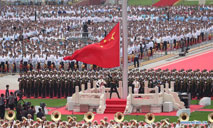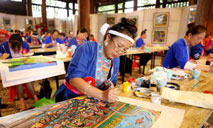Chinese scientists make breakthroughs in high-precision magnetic chip testing
BEIJING, July 2 (Xinhua) -- Scientists from Beihang University in Beijing have developed a high-precision testing machine that can be applied to magnetic thin film testing in magnetic chip production.
With a magnetic probe of the machine, the researchers successfully wrote down several Chinese characters on the magnetic films with only five atomic layers of thickness, equivalent to one hundred-thousandth of the thickness of a piece of ordinary printing paper.
In magnetic chip production, nanoscale magnetic thin films need to be evenly spread out on wafers, a substrate used for making silicon semiconductor integrated circuits.
The process is like spreading five layers of millet evenly across more than 400 square kilometers, which requires precise testing of the flatness of the thin film, said Zhang Xueying, a teacher at the School of Integrated Circuit Science and Engineering, Beihang University.
The research team uses the self-developed wafer-level magneto-optical Kerr effect tester to take an image of the characters written on the thin films. A consistent color contrast of words and a clear writing trace can indicate the flatness of the thin film. After the testing, the films can be used to make magnetic chips, according to Zhang.
"Compared with similar magneto-optical testing equipment developed by other countries, the new machine has shown breakthroughs and innovation in accuracy and speed," said Wang Xinhe, dean of the department of technology and equipment under the School of Integrated Circuit Science and Engineering, Beihang University.
Magnetic chips can be used as highly reliable information storage modules and sensitive magnetic signal sensing modules used in the control systems of aircraft and satellites, or fields including mobile phone electronic compass and automatic driving.
The new testing machine is expected to be put into commercial use around October 2021, according to the research team.
Photos
Related Stories
- Chinese scientists help Sri Lanka cope with marine disasters, climate change
- Chinese scientists discover ultra-high-energy Milky Way cosmic accelerators
- Chinese scientists build unmanned amphibious aircraft
- Chinese scientists discover neopterygian fish fossil 244 mln-year ago
- Chinese chipmakers eye global glory
- Chinese scientists develop flexible sodium-ion microcapacitors
- Chinese scientists promote hornless yaks to herding areas
- Chinese scientists develop new high-safety microbattery
- Chinese scientists improve the performance of wound dressings
- China approves new lithography machine for chip production
Copyright © 2021 People's Daily Online. All Rights Reserved.










